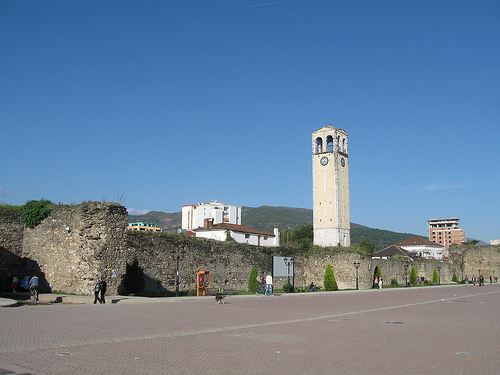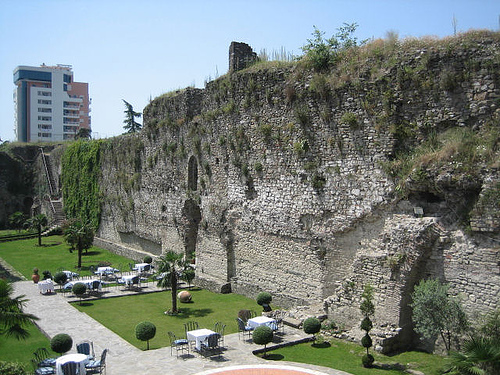

Hotels, motels and where to sleep
Restaurant, taverns and where to eat

Location: Elbasan
Built: 15th century
Elbasan Castle is a Turkish citadel
constructed by the Ottoman Turks in the 15th century. It controls
Ancient Roman road Via Egnatia that was in use centuries after its
construction. In addition, the Roman ruins of ancient Roman
buildings were used to build a medieval citadel. Elbasan Castle was
defended by 26 towers and walls 9 meters high. Today this landmark
is open to the public. Here you will find the remains of the Sinan
Pasha's Turkish
baths built in the 19th century, and of course a small restaurant
near the old walls. It is a well-preserved attraction built in the
early 19th century.
History
The i. e. With the Third Roman-Illyrian
War of 168, with the Roman subjugation of Illyria in the i. e. In
the second half of the 2nd century, the construction of the Via
Egnatia, a road connecting the Adriatic coast with Byzantium, began.
On this, a mansion, or station called Scampis or Scampa, was
established on the site of present-day Elbasan. Based on
archaeological excavations, the in the 1st century, the settlement
was already administratively belonging to Dyrrhachium. In the 4th
century, the Romans built a castrum in Scampis for military
purposes, which was suitable for stationing an entire legion. The
fortified city has been depicted on maps such as the Itinerarium
Burdigalense (Scampis) and the Tabula Peutingeriana (Hiscampis)
since the 4th century.
Middle Ages
Scampis, which came
under Byzantine rule after the collapse of the Roman Empire,
presumably became an episcopal seat in the 5th century. The
two-century-old Roman castrum was fortified during the time of the
Byzantine emperor Justinian I (ruled. 527–565) and was named
Scheminites in the list of fortifications in Epirus Nova that he had
rebuilt. In his work, the 6th-century geographer Hierocles
mentioned the city as an important city and episcopal seat, but it
became depopulated in the 7th century, but not later than the 9th
century, due to repeated attacks, mainly related to the Slavs and
Bulgarians.
Ottoman occupation
Ruler of the Ottoman Empire
in the Western Balkans, II. Mehmed rebuilt the castle on a Byzantine
basis in 1466, and the settlement thus acquired was given the name
Ilbasan (modern Turkish İlbasan) or Ilibasan, meaning ‘strong v.
fortified place; fortification ’. Built into the arch of the
southern castle gate, II. A memorial stone glorifying Mehmet also
testifies that the architect of the castle was a certain Yusufi, and
the works took only a month in the summer of 1466. From the 16th
century, the castle and the surrounding settlement became the seat
of the Ilbaszan Sandzak, an important commercial and handicraft
center with a strong Islamic culture, and one of the most important
settlements in Albanian-inhabited areas. In the 1770s, the castle
was taken over by the Pasha Mehmed Bushatlliu of the Sandzak Beg in
Iskodra, and then in 1811 by Pasha Ali Tepeleni. Ten years after his
defeat, in 1832, at the behest of Pasha Mehmed Resid Mehmed, the
Sultan's Grand Chief, the fortress of Ilbaszan was dismantled and
partially demolished. After that, the castle quarter (Kalaja) became
the city quarter of the Greek Orientals of Ilbaszan.
Description
Built on Roman and Byzantine foundations, Elbasan
Castle is one of the rare lowland fortresses in Albania, next to
Peqini and Bashtova. The castle was archaeologically surveyed by
Ylli Cerova in 1987–1988. During the excavation at the south-west
corner bastion, a Roman barracks, a 4–5. The foundations of an early
Christian church were discovered in the 16th and 19th centuries, as
well as 4 to 6 meters of cultural layers, the four settlement
periods of which were separated: 3–4. century, 5-6. century, 11–15.
century, Ottoman era.
In the 4th century, the wall of the
original castrum was erected from stones obtained from the bed of
the nearby river by mortar bonding. The rectangular fortification,
roughly 300 x 300 meters, was crossed east-west by Via Egnatia,
which became the decumanus maximus of the orthogonal town, with the
cardo maximus leaving the castrum perpendicular to it through the
southern city gate. The three main city gates - west, east and south
- were lined on both sides by a semicircular tower, with round
bastions at four corners of the castrum and additional towers every
40-50 meters along the wall; their total number was twenty. Inside
the wall, vaulted stone stairs led to the towers and the wall, and
from the outside a lower protective wall (proteichisma) and a deep,
stone-lined moat lined the wall. Two centuries later, the Byzantines
reinforced it with the opus mixtum (wd) technique, that is, the
former stone wall was raised with rows of bricks. In 1466, the walls
of the Ottoman castle were partly built on the foundations of the
ancient fortress, but its area was slightly increased: the length of
the side walls became 362 × 327 meters. In parallel, the number of
towers increased, twenty-eight towers ensured the protection of the
castle. In place of the previous ones, the three city gates have
survived, of which the southern Bazaar Gate, which provides access
to the city's bazaar, became the most important over time. On the
floor above the gate was built Ilbasan’s first Muslim house of
worship, the Mehmet Sultan Mosque without a minaret, which has now
been destroyed.
Today, the entire length of the south wall and 9 meters high, along with its two corner bastions, six towers and the Bazaar Gate, have been preserved completely intact, in addition to which the walls of the southeast and west sides are partially standing. Notable architectural monuments in the castle district are the King Mosque (Xhamia e Mbretit) built in 1492, the 17th century Old Baths (Hamami i Vjetër) and the Orthodox Church of the Virgin Mary (Kisha e Shën Mërisë) completed in 1868. In the garden of the latter church stands the tomb and bust of Kostandin Kristoforidhi, a native of the city, a 19th-century Bible translator. On the south castle wall, a 30-meter-high clock tower was built in 1898 on the site of an earlier tower built in the 17th century, and on the outside of the wall, a promenade with monuments and statues of famous Elbasanis was built in the early 21st century. Archaeological excavations earlier than the southwestern bastion now house a restaurant with the foundations of a Roman barracks (possibly a dwelling house), pagan tombstones, the headstones of an early Christian basilica, and some Ottoman-era tombstones.
Get in
About 45 minute ride from Tirana with the bus through
the semi-finished new motorway that is still being built as in 2018.
The new motorway was opened in 2012 and now you can go from Tirana
to Elbasan much faster. Beside the new motorway you can see the
beautiful landscapes.
Get around
Walking or taxi. Taxis
are located close to the furgons (vans) at the center of the city.
There are Imperial Hotel and Skampa Hotel in the city. You can sleep at a Couchsurfer's house for free. Albanians are very generous and really good hosts.
Bugaçe, a traditional Elbasan breakfast roll found nowhere else
in Albania. Smothered in butter and with a dash of salt, this roll
is delicious but not the those watching their cholesterol.
Bollokume, another Elbasan specialty rarely found elsewhere in
Albania. It is essentially a large sugar cookie. While sold in
stores all over the city, the best are always the freshly baked warm
cookies.
Try the traditional Tavë Elbasani and other yummy
specialties.
Trilece at the restaurant across from the clock
tower is especially good.
The tallest building in Elbasan, one
block from the center and easily identifiable, has a rotating
restaurant/bar on the top floor. If for nothing else, go for the
view.
Drink
Cokollate e zeze (black chocolate). It's like
hot chocolate, but almost as thick as pudding and eaten with a
spoon.
Traditional costumes, postcards of the city.